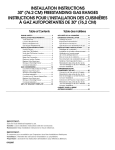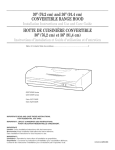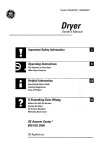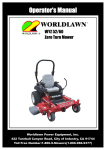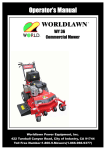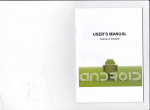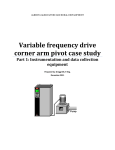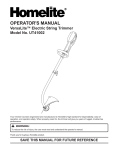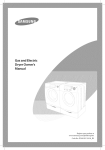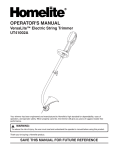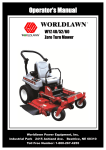Download Sears Kenmore 29-Inch Wide ELECTRIC DRYERS Owner`s manual
Transcript
Owner's Manual and
Installation Instructions
29-Inch Wide
ELECTRIC DRYERS
IMPORTANT:
Read and follow all safety
and operating instructions
before first use of this product.
Sears, Roebuck and Co., Hoffman Estates, IL 60179 U.S.A.
www.sears.com
3979089B
PRINTED IN U.S.A.
12/01
BEFORE USING YOUR NEW DRYER
KENMORE DRYER WARRANTY
DRYER SAFETY
4
INSTALLATION INSTRUCTIONS
6
DRYER USE
19
LAUNDRYTIPS
25
DRYER CARE
27
TROUBLESHOOTING
30
WE SERVICE WHAT WE SELL
32
Please read this manual. It will help
you install and operate your new
Kenmore dryer in the most economical
way.
If you need more information about the
care and operation of Kenmore appliances
call your nearest Sears store. You will
need the complete model and
serial numbers when requesting
information. Your dryer's model and
serial numbers are located on the Model
and Serial Number Plate.
Product Record
Use the space below to record the model
number and serial number of your new
Kenmore dryer.
Model No.
Serial No.
Date of Purchase
Model No. and
Serial No. Plate
Keep this book and your Sears
Salescheck (receipt) in a safe
place for future reference.
2
Full One Year Warranty on
Mechanical and Electrical Parts
For one year from the date of purchase,
if this dryer is installed and operated
according to the instructions in this
manual, Sears will repair or replace any
of its mechanical or electrical parts if they
are defective in material or workmanship.
NOTE: Exhausting your dryer with
a plastic vent may void this warranty.
See "Installation Instructions" for the
complete exhaust requirements
for this dryer.
Warranty
Restriction
If the dryer is subjected to other than
private family use, all warranty coverage is
effective for only 90 days.
Warranty Service
Warranty service is available by contacting
your nearest Sears Service Center in the
United States.
This warranty applies only while this dryer
is in use in the United States.
This warranty gives you specific legal
rights, and you may also have other rights
which vary from state to state.
Sears, Roebuck and Co., Dept. 817WA,
Hoffman Estates, IL 60179,
For Sears Warranty information or 1ocontact a Sears
Service Cenler, please reference the service numbers
located on the back page of lhis manual.
Your safety and the safety of others are very important.
We have provided many importantsafety messages in this manual and
on your appliance. Always read and obey all safety messages.
This is the safety alert symbol. This symbol alerts you to
potential hazards that can killor hurtyou and others.
All safety messages will follow the safety alert symbol
and either the word "DANGER" or 'WARNING."
These words mean:
You can be killed or seriously
injured if you don't immediately
follow instructions.
You can be killed or seriously
injured if you don't follow
instructions.
All safety messages will tell you what the potentialhazard is, tell you how
to reduce the chance of injury, and tell you what can happen if the
instructionsare not followed.
4
IMPORTANT
SAFETY
INSTRUCTIONS
WARNING
: To reduce the risk of fire, electric shock, or injury to persons
when using the dryer, follow basic precautions, including the following:
• Read all instructions before using
the dryer.
• Do not place items exposed to cooking oils in your dryer. Items contaminated with cooking oils may contribute
to a chemical reaction that could
cause a load to catch fire.
• Do not dry articles that have been previously cleaned in, washed in, soaked
in, or spotted with gasoline, drycleaning solvents, other flammable, or
explosive substances as they give off
vapors that could ignite or explode.
• Do not allow children to play on or in
the dryer. Close supervision of
children is necessary when the dryer
is used near children.
• Before the dryer is removed from
service or discarded, remove the door
to the drying compartment.
• Do not reach into the dryer if the drum
is moving.
• Do not install or store the dryer where
it will be exposed to the weather.
• Do not tamper with controls.
SAVE THESE
• Do not repair or replace any part of
the dryer or attempt any servicing
unless specifically recommended in
this Owner _ Manual or in
published user-repair instructions
that you understand and have the
skills to carry out.
• Do not use fabric softeners or
products to eliminate static unless
recommended by the manufacturer
of the fabric softener or product.
• Do not use heat to dry articles
containing foam rubber or similarly
textured rubber-like materials.
• Clean lint screen before or after
each load.
• Keep area around the exhaust
opening and adjacent surrounding
areas free from the accumulation
of lint, dust, and dirt.
• The interior of the dryer and
exhaust vent should be cleaned
periodically by qualified service
personnel.
• See the "INSTALLATION
INSTRUCTIONS" section for
grounding requirements.
INSTRUCTIONS
Tools and Parts
Location
Requirements
Check that you have everything necessary for correct installation. Proper
installation is your responsibility.
• flat-blade screwdriver
• adjustable wrench that opens to 1 in.
or hex-head socket wrench (for
adjusting dryer feet)
level
wire stripper (direct wire installations)
#2 Phillips screwdriver
safety glasses
duct tape
caulking gun and compound (for
installing new exhaust vent)
• gloves
• tin snips (new vent installations)
Parts supplied:
Remove parts package from dryer drum.
Check that all parts were included.
4 leveling legs
Parts needed:
Check local codes, check existing electrical supply and venting and see
"Electrical Requirements" and "Venting
Requirements" before purchasing parts.
Mobile home installations require:
• Metal exhaust system hardware available for purchase from your local
Sears store or Sears Service Center.
Explosion Hazard
Keep flammable materials and vapors,
such as gasoline, away from dryer.
Place dryer at least 18 inches (46 cm)
above the floor for a garage
installation.
Failure to do so can result in death,
explosion, or fire,
You will need
• A location that allows for proper
exhaust installation. See "Venting
Requirements."
• A separate 30 amp circuit.
• A grounded electrical outlet located
within 2 ft (61 cm) of either side of the
dryer. See "Electrical Requirements."
• A sturdy floor to support the total dryer
weight of 200 Ibs (90.7 kg).
• A level floor with a maximum slope of
1 in. (2.5 cm) under entire dryer. (If
slope is greater than 1 in. [2.5 cm],
install Extended Dryer Feet kit, Part
No. 279810.) Clothes may not tumble
properly and dryers with automatic
sensor cycles may not operate
correctly if dryer is not level.
Do not operate or store your dryer in a
location with year-round temperatures
below 45°F (7°C). At lower temperatures,
the dryer might not shut off at the end of
an automatic cycle. Drying times can be
extended.
Install the dryer where it is protected from
water and/or weather.
Check code requirements. Some codes
limit, or do not permit, installation of the
dryer in garages, closets, mobile homes,
or sleeping quarters. Contact your local
building inspector.
6
Installation Clearances
The location must be large enough to fully
open the dryer door.
Dryer Dimensions
(110
273/1_
"
(69,05 c
\
1 Small Opening Side-Swing
Doer
__ 29"_
\
3. Wide Opening Side-Swing
Doer
22_/#*
\
_7(73.66
29,,_
era)
2. Large Opening Side-Swing
Door
*Most installations require a minimum 51_2
in. (14 cm) clearance behind the dryer
for the exhaust vent with elbow. See
"Venting Requirements."
Minimum installation spacing for
recessed area or closet installation
The dimensions shown following are for
the minimum spacing allowed.
• Additional spacing should be
considered for ease of installation and
servicing.
• Additional clearances might be
required for wall, door and floor
moldings.
• Additional spacing of 1 in. (2.5 cm) on
all sides of the dryer is recommended
to reduce noise transfer.
• For closet installation, with a door,
minimum ventilation openings in the
top and bottom of the door are
required. Louvered doors with
equivalent ventilation openings are
acceptable.
• Companion appliance spacing should
also be considered.
o,o
(46.7m_)
JE
m
m
t"
(_)
_,5 t_11)
_,5 crn) (69 O5 cm) (14 cm)
1
2
_3"
48 ,*z
1310=rn2)-
24,,z
1155crM)
_-3"
3
_.e_)
1 RecessedArea
2 Side view - closet or confined
area
3 Closet door with vents
Mobile Home-Additional Installation
Requirements
This dryer is suitable for mobile home
installations. The installation must conform to the Manufactured Home
Construction and Safety Standard, Title
24 CFR, Part 3280 (formerly the Federal
Standard for Mobile Home Construction
and Safety, Title 24, HUD Part 280)
8
Mobile home installations require:
• Metal exhaust system hardware which
is available for purchase from your
local Sears store or Sears Service
Center.
• Special previsions must be made in
mobile homes to introduce outside air
into the dryer. The opening (such as a
nearby window) should be at least
twice as large as the dryer exhaust
opening
Electrical
Requirements
It is your responsibility:
• To contact a qualified electrical
installer.
• To be sure that the electrical connection is adequate and in conformance
with the National Electrical Code,
ANSl/NFPA 70-latest edition and all
local codes and ordinances.
A copy of the above code standards
can be obtained from: National Fire
Protection Association, Batterymamh
Park, Quincy, MA 02269.
• To supply the required 3 or 4 wire, single phase, 120/240-volt, 60-Hz., AConly electrical supply (or 3 or 4 wire,
120/208-volt electrical supply, if specified on the serial/rating plate) on a
separate 30-amp circuit, fused on both
sides of the line. A time-delay fuse or
circuit breaker is recommended.
Connect to an individual branch circuit.
Do not have a fuse in the neutral or
grounding circuit.
• Do not use an extension cord.
• If codes permit and a separate ground
wire is used, it is recommended that a
qualified electrician determine that the
ground path is adequate.
Electrical Connection
To properly install your dryer, you must
determine the type of electrical connection you will be using and follow the
instructions provided for it here.
• If local codes do not permit the connection of a cabinet ground connector
to the neutral wire, see "Optional 3-wire
connection" section.
• This dryer is manufactured with a 3wire, cabinet-ground conductor connected to the NEUTRAL (white or center wire) of the wiring harness at the
terminal block.
• Use a 4-wire conductor cord when the
dryer is installed in a mobile home or
an area where local codes do not permit grounding through the neutral.
If using a power supply cord:
Use a UL approved power supply cord kit
marked for use with clothes dryers, the
kit should contain:
• A UL approved 30 amp power supply
cord, rated 120/240 volt minimum. The
cord should be type SRD or SRDT and
be at least 4 ft (1.22 m) long. The wires
that connect to the dryer must end in
ring terminals or spade terminals with
upturned ends.
• A UL approved strain relief.
If your outlet looks like this:
©
4_wire receptacle
(14_30R)
Then choose a 4-wire power supply cord
with ring or spade terminals and UL
approved strain relief. The 4-wire power
supply cord, at least 4 ft (1.22 m) long,
must have 4, 10 gauge solid copper
wires and match a 4-wire receptacle of
NEMA Type 14-30R. The ground wire
(ground conductor) may be either green
or bare. The neutral conductor must be
identified by a white cover.
If your outlet looks like this:
©
3_wire receptacle (10_30R)
Then choose a 3-wire power supply cord
with ring or spade terminals and UL
approved strain relief. The 3-wire power
supply cord, at least 4 ft (1.22 m) long,
must have 3, No.-10 copper wires and
match a 3-wire receptacle of NEMA Type
10-30R.
If connecting by direct wire:
Power supply cable must match power
supply (4-wire or 3-wire) and be:
• Flexible armored or non-metallic
sheathed copper cable (with ground
wire). All current-carrying wires must
be insulated.
• 10 gauge solid copper wire (Do not use
aluminum.)
• At least 4 ft (1.22 m) long
GROUNDING
INSTRUCTIONS
• For a grounded, cord-connected dryer:
This dryer must be grounded. In the
event of malfunction or breakdown,
grounding will reduce the risk of electric
shock by providing a path of least resistance for electric current. This dryer
uses a cord having an equipmentgrounding conductor and a grounding
plug. The plug must be plugged into an
appropriate outlet that is properly
installed and grounded in accordance
with all local codes and ordinances.
• For a permanently connected dryer:
This dryer must be connected to a
grounded metal, permanent wiring
system, or an equipment-grounding
conductor must be run with the circuit
conductors and connected to the equipment-grounding terminal or lead on the
dryer.
WARNING:
Improper connection
of the equipment-grounding conductor
can result in a risk of electric shock.
Check with a qualified electrician or
service representative or personnel if
you are in doubt as to whether the
appliance is properly grounded.Do not
modify the plug on the power supply
cord: if it will not fit the outlet, have a
proper outlet installed by a qualified
electrician.
SAVE THESE INSTRUCTIONS
Electrical
Connection
Direct Wire
Power Supply Cord
Fire Hazard
Fire Hazard
Use a new UL approved 30 amp
power supply cord.
Use 10 gauge solid copper wire.
Use a UL approved strain relief.
Use a UL approved strain relief.
Disconnect power before making
electrical connections.
Disconnect power before making
electrical connections.
Connect neutral wire (white or center
wire) to center terminal (silver).
Connect neutral wire (white or center
wire) to center terminal (silver).
Ground wire (green or bare wire) must
be connected to green ground
connector.
Ground wire (green or bare wire)
must be connected to green ground
connector.
Connect remaining 2 supply wires
to remaining 2 terminals (gold).
Connect remaining 2 supply wires to
remaining 2 terminals (gold).
Securely tighten all electrical
connections.
Securely tighten all electrical
connections.
Failure to do so can result in death,
fire, or electrical shock.
Failure to do so can result in death,
fire, or electrical shock.
1. Disconnect power.
2. Remove the hold-down screw and
terminal block cover.
!
2
Terminal block cover
External ground connector
Center, silver-colored terminal_block
screw
4. Hold_down screw location
E Neutral grounding wire (green/yellow)
6. Hole below terminal block opening
10
3,
Assemble a 3/4 in. (1.9 cm) UL
approved strain relief (UL marking on
strain relief) into the hole below the
terminal block opening. Tighten strain
relief screws just enough to hold the
two clamp sections together. Put
power supply cord through the strain
relief. The strain relief should have a
tight fit with the dryer cabinet and be
in a horizontal position.
4. Now complete installation following
instructions for your type of electrical
connection:
4-wire (recommended)
3-wire (if 4-wire is not available)
_E!e c tricaJ_q_%nnec_jon_
_9_ _ops....................
If your
home has:
And you
will be
connecting
to:
4-wire receptacle
A UL listed
NEMAType 14-30R 120/240 volt
minimum, 30
amp., dryer
power supply
cord*
4-wire direct
Go to
Section:
4-wire
connection:
1. Remove center terminal block screw.
2. Remove appliance ground wire (green
with yellow stripes) from external
ground connector screw. Fasten it
under center, silver colored terminal
block screw.
1
Power
Supply
Cord
A fused
4-wire
disconnect or connection:
circuit breaker
box*
Direct Wire
3-wire receptacle
A UL listed,
(NEMAtype 10-30R) 120/240 volt
minimum, 30
amp., dryer
power supply
cord*
3-wire direct
2
3-wire
connection:
Power
Supply
Cord
A fused
3-wire
disconnect or connection:
circuit breaker
box*
Direct Wire
*If local codes do not permit the
connection of a frame-grounding
conductor to the neutral wire, go to
"Optional 3-wire connection" section.
0
3
1 External ground connector - Dotted
line shows position of NEUTRAL
ground wire before being moved to
center terminal block screw
2 Center silver-colored terminal block
screw
& Green/yellow
wire of harness
3. Connect ground wire (green or bare)
of power supply cord to extemal
ground conductor screw. Tighten
screw.
4. Connect neutral wire (white or center
wire) of power supply cord under center screw of the terminal block.
4-wire connection: Power Supply Cord
4
5
IMPORTANT: A 4-wire connection is
required for mobile homes and where
local codes do not permit the use of 3-wire
connections.
2
3
4
6
1. 3j_ in. (1.9 cm), ULqisted strain relief
2 Green wire of power supply cord or
bare copper wire
3. External ground connector
4. Center silver-colored terminal block
screw
5
7
1.4-wire receptacle (NEMA type 14_30R)
2. 4-prong plug
3. Ground prong
4. Neutral prong
5. Spade terminals with upturned ends
6. 3/_ in. (1.9 cm) UL approved strain relief
7. Ring terminals
5. Neutral wire (white)
6. Neutral grounding wire (green/yellow)
5. Connect the other wires to outer terminal block screws. Tighten screws.
6. Tighten strain relief screws.
7. Insert tab of terminal block cover into
slot of dryer rear panel. Secure cover
with hold-down screw.
11
4-wire connection:
Direct Wire
IMPORTANT: A 4-wire connection is
required for mobile homes and where
local codes do not permit the use of 3wire connections.
Direct wire cable must have 5 ft (1.52 m)
of extra length so dryer can be moved if
needed.
Strip 5 in. (12.7 cm) of outer covering
from end of cable, leaving bare ground
wire at 5 in. (12.7 cm). Cut 1lj2 in. (3.8
cm) from 3 remaining wires. Strip
insulation back 1 in. (2.5 cm). Bend ends
of wires into a hook shape.
Connect ground wire (green or bare)
of power supply cable to external
ground conductor screw. Tighten
screw.
4. Place the hooked end of the neutral
wire (white or center wire) of power
supply cable under the center screw
of terminal block (hook facing right).
Squeeze hooked end together. You
now have the appliance ground wire
and the neutral wire on the same terminal. Tighten screw.
3.
4
When connecting to the terminal block,
place the hooked end of the wire under
the screw of the terminal block (hook
facing right), squeeze hooked end
together and tighten screw.
1. Remove center terminal block screw.
2. Remove appliance ground wire (green
with yellow stripes) from external
ground connector screw. Fasten it
under center, silver colored terminal
block screw.
1
2
©
3
1. External ground connector - Dotted
line shows position of NEUTRAL
ground wire before being moved to
center terminal block screw
2. Center silver-colored terminal block
screw
3. Green/yellow wire of harness
12
5.
5
1
1.3/4 in. (1.9 cm), UL-listed strain relief
2. Green or bare copper wire of power
supply cord
3. External ground connector
4. Center silver-colored terminal block
screw
5. Neutral wire (white)
6. Neutral grounding wire (green/yellow)
Place the hooked ends of the other
power supply cable wires under the
outer terminal block screws (hooks
facing right). Squeeze hooked ends
together. Tighten screws.
!! !!
6. Tighten strain relief screws.
7. Insert tab of terminal block cover into
slot of dryer rear panel. Secure cover
with hold-down screw.
3-wire connection:
Use where local codes permit connecting cabinet-ground conductor to
neutral wire:
l
3
Use where local codes permit connecting cabinet-ground conductor to
neutral wire.
Direct wire cable must have 5 ft (1.52 m)
of extra length so dryer can be moved if
needed.
Strip 31/2in. (8.9 cm) of outer covering
from end of cable. Strip insulation back 1
in. (2.5 cm). If using 3-wire cable with
ground wire, cut bare wire even with
outer covering. Bend ends of wires into a
hook shape.
1
4
Direct Wire
5
7
6
1.3-wire receptacle (NEMA type 10-30R)
2. 3-wire plug
3. Neutral prong
4. Spade terminals with upturned ends
5. 3/4 in. (1.9 cm) UL approved strain
relief
6. Ring terminals
7. Neutral (white or center wire)
Loosen or remove center terminal
block screw.
2. Connect neutral wire (white or center
wire) of power supply cord to the center, silver colored terminal screw of
the terminal block. Tighten screw.
When connecting to the terminal block,
place the hooked end of the wire under
the screw of the terminal block (hook facing right), squeeze hooked end together
and tighten screw.
t.
1. Neutral grounding
wire (green/yellow)
3
J_
2
/
S
S
F_
_
,............
1. Loosen or remove center terminal
block screw.
2. Place the hooked end of the neutral
wire (white or center wire) of power
supply cable under the center screw
of terminal block (hook facing right).
Squeeze hooked end together.
Tighten screw.
3
2
/
1/
_.
5
2. Extemal ground connector
3. Center silver-colored terminal block
screw
4. Neutral wire (white)
5. 3/4 in. (1 9 cm) UL-listed strain relief
3. Connect the other wires to outer terminal block screws. Tighten screws.
4. Tighten strain relief screws.
5. Insert tab of terminal block cover into
slot of dryer rear panel. Secure cover
with hold-down screw.
1. Neutral grounding wire (green/yellow)
2. External ground connector
3 Center silver-colored terminal block
screw
4. Neutral wire (white)
5. 3/4 in.(19 crn) UL-listed strain relief
13
3. Place the hooked ends of the other
power supply cable wires under the
outer terminal block screws (hooks
facing right). Squeeze hooked ends
together. Tighten screws.
6. Connect a separate copper ground
wire from the external ground connector screw to an adequate ground.
2
!! !!
4. Tighten strain relief screws.
5. Insert tab of terminal block cover into
slot of dryer rear panel. Secure cover
with hold-down screw.
Optional
3-wire connection
Use for direct wire or power supply
cord where local codes do not permit
connecting cabinet-ground conductor
to neutral wire.
1. Remove center terminal block screw.
2. Remove appliance ground wire (green
with yellow stripes) from external
ground connector screw. Connect
appliance ground wire and the neutral
wire (white or center wire) of power
supply cord/cable under center, silver
colored terminal block screw. Tighten
screw.
3. Connect the other wires to outer terminal block screws. Tighten screws.
!!!!
4. Tighten strain relief screws.
5. Insert tab of terminal block cover into
slot of dryer rear panel. Secure cover
with hold-down screw.
14
1.
2.
3.
4.
External ground connector
Neutral grounding wire (green/yellow)
Neutral wire (white)
Grounding path determined by a
qualified electrician
Rigid metal vent is recommended to prevent crushing and kinking.
Venting Requirements
Flexible metal vent must be fully extended and supported when the dryer is in its
final position. Remove excess flexible
metal vent to avoid sagging and kinking
that may result in reduced airflow.
An exhaust hood should cap the vent to
prevent rodents and insects from
entering the home.
Exhaust hood must be at least 12 in.
(30.5 cm) from the ground or any object
that may be in the path of the exhaust
(such as flowers, rocks or bushes, etc.).
Fire Hazard
Use a heavy metal vent.
Do not use a plastic vent.
Do not use a metal foil vent.
Failure to follow these instructions
can result in death or fire.
If using an existing vent system, clean
lint from the entire length of the system
and make sure exhaust hood is not
plugged with lint. Replace any plastic or
metal foil vent with rigid metal or flexible
metal vent.
WARNING: To reduce the risk of
fire, this dryer MUST BE EXHAUSTED
OUTDOORS.
Use duct tape to seal all joints.
4 in. (10.2 cm) heavy metal exhaust vent
and clamps must be used. DURASAFE
venting products are recommended and
are available from your local Sears store
or Sears Service Center.
TM
DURASAFE vent products can be
purchased from your dealer. Please reference the service numbers located on
the back of the manual or visit our
Internet site at: www.sears.com.
Plan Vent System
Typical Exhaust Installations
Typical installations vent the dryer from
the rear of the dryer.
2
/
• Do not exhaust the dryer into any gas
vent, chimney, wall, ceiling, or a
concealed space of a building.
• Do not use an exhaust hood with a
magnetic latch.
• Do not install flexible metal vent in
enclosed walls, ceilings or floors.
• Do not use screws or other fastening
devices that extend into the interior of
the vent to secure vent.
IMPORTANT: Observe all governing
codes and ordinances.
Improper venting can cause moisture
and lint to collect indoors, which may
result in:
Moisture damage to woodwork,
furniture,paint, wallpaper, carpets, etc.
Housecleaning
problems.
I!
/-
k
3
/
1.
2.
3.
4.
Dryer
Elbow
Wall
Exhaust hood
5. Duct tape and clamps
6. Rigid metal or flexible metal vent
7. Vent length necessary to connect
elbows
8. Exhaust outlet
problems and health
Jse a heavy metal vent. Do not use plastic or metal foil vent.
15
Standard exhaust installation with rigid
metal or flexible metal vent
Special provisions for mobile home
installations
The exhaust vent must be securely fastened to a noncombustible portion of the
mobile home structure. Do not use screws
or other fastening devices that extend into
Alternate installations for close
clearances
Venting systems come in many varieties.
Select the type best for your installation.
Two close-clearance installations are
shown. Refer to the manufacturer's
instructions.
1. Over-The-Top installation (also
available with one offset elbow)
2. Periscope installation
the interior of the vent to se{ ure vent.
Terminate the exhaust vent outside. The
exhaust vent must not terminate beneath
the mobile home and must not be
connected to any other duct, vent or chimDetermine vent length
1. Select the route that will provide the
straightest and most direct path outdoors. Plan the installation to use the
fewest number of elbows and turns.
When using elbows or making tums,
allow as much room as possible. Bend
vent gradually to avoid kinking. Avoid
90 ° turns.
NOTE: The following kits for close clearance altemate installations are available
for purchase. Please see the service number located on the back page of this manual to order.
• Over-The-Top Installation:
Part Number 26-49900
• Periscope Installation (For use with dryer
vent to wall vent mismatch):
Part Number 26-49901 - Less than 5 in.
(12.7 cm) mismatch
Part Number 26-49908 - 5 in. (12.7 cm)
to 18 in. (45.72 cm) mismatch
Part Number 26-49904 - 18 in. (45.72
cm) to 29 in. (73.66 cm) mismatch
Part Number 26-49905 - 29 in. (73.66
cm) to 50 in. (127 cm) mismatch
16
2. Determine vent length.
The maximum length of the exhaust
system depends upon:
• The type of vent (rigid metal or
flexible metal).
• The number of elbows used.
• Type of hood.
Recommended
here.
hood styles are shown
Install Vent System
1. (Optional) Put on safety glasses and
gloves.
2. Install exhaust hood. Use caulking compound to seal exterior wall opening
around exhaust hood.
3. Connect vent to exhaust hood. Vent
must fit inside exhaust hood. Secure
vent to exhaust hood with 4 in.
(10.2 cm) clamp.
4. Run vent to dryer location. Use the
straightest path possible. See
"Determine Vent Length." Avoid 90 °
rums. Use duct tape to seal all joints.
1
(10.2
cm)
1. Louvered hood style
2. Box hood style
The angled hood style (shown following)
is acceptable.
Install Leveling
4"
Legs
(10.2__
Excessive Weight Hazard
Use two or more people to move
and install dryer.
Failure to do so can result in back
or other injury.
,ds 'm,
See the exhaust vent length chart that
matches your hood type for the maximum vent lengths you can use.
Exhaust systems longer than specified
will:
1. Place two of the carton corner posts
on the floor behind the back of the
dryer. See illustration.
• Shorten the life of the dryer.
• Reduce performance, resulting in longer
drying times and increased energy
usage.
3. Determine the number of elbows you
will need.
NOTE: Do not use vent runs longer
than specified in Vent Length Chart.
The chart below helps you
your maximum vent length
the number of 90 ° turns or
[rOUwill need and the type
igid or flexible metal) and
you will use.
2. Firmly grasp the body of the dryer
(not the top or console panel).
determine
based on
elbows
of vent
hood that
Gently lay the dryer on the cardboard
corners.
Vent Length Chart
3. Examine the leveling legs. Find the
Numberof
Type of
Box or
Angled
diamond marking.
90° turns
vent
Louvered
hoods
or elbows
hoods
0
Rigidmetal 64ft(20m)
58 ft(17,7m)
Flexible metal 36 ft (11m) 28 ft (8.5m)
1
Rigid metal 54 ft (16.5m) 48 ft (14.6m)
Flexible metal
31 ft (9.4m) 23 ft (7 m)
2
Rigid metal
44ft (13.4m) 38 ft (11.6m)
Flexible metal
3
Rigid metal 35ft(1O.7m) 29ft(8.8m)
Flexible metal 25 ft (7.6m) 17 ft (5.2m)
Rigid metal 27 ft (8.2m) 21 ft (6.4m)
27ft (8.2m) 19ft(5.8m)
4
.............................................................
4. Screw the legs into the leg holes by
hand. Use a wrench to finish tuming
the legs until the diamond marking is
no longer visible.
5, Stand the dryer up. Move it close to
its final location. Leave enough room
..........to connect the exhaust vent.
17
Level Dryer
Check the levelness of the dryer. Check
levelness first side-to-side, then front-toback.
If the dryer is not level, prop up the dryer
using a wood block. Use a wrench to
adjust the legs up or down and check
again for levelness.
NOTE: It might be necessary to level the
dryer again after it is moved into its final
position.
Connect
Vent
1. Using a 4 in. (10.2 cm) clamp, connect vent to exhaust outlet in dryer. If
connecting to existing vent, make sure
the vent is clean. The dryer vent must
fit over the dryer exhaust outlet and
inside the exhaust hood. Make sure
the vent is secured to exhaust hood
with a 4 in. (10.2 cm) clamp.
2. Move dryer into final position. Do not
crush or kink vent. Make sure dryer is
level.
Complete
Installation
1. Check to be sure all parts are now
installed. If there is an extra part, go
back through the steps to see which
step was skipped.
2. Check to be sure you have all of
you r tools.
3. Dispose of all packaging materials.
4. Check the dryer's final location. Be
sure the vent is not crushed or
kinked.
5. Check to be sure the dryer is level.
(See "Level Dryer.")
6. Plug into a grounded outlet. Turn
power on.
7. Remove the blue protective film on
the console and any tape remaining
on the dryer.
8. Read "Dryer Use."
g. Wipe the dryer drum interior
thoroughly with a damp cloth to
remove any dust.
10. Set the dryer on a full heat cycle (not
the Air cycle) for 20 minutes and
start the dryer.
If the dryer will not start, check
the following:
• Controls are set in a running or
"On" position.
• Start button has been pushed
firmly.
• Dryer is plugged into a grounded
outlet.
• Electrical supply is connected.
• House fuse is intact and tight or
circuit breaker has not tripped.
• Dryer door is closed.
11. When the dryer has been running
for 5 minutes, open the dryer door
and feel for heat.
If you do not feel heat, turn the
dryer off and check the following:
• There may be 2 fuses or circuit
breakers for the dryer. Check to
make sure both fuses are intact
and tight, or that both circuit breakers have not tripped. If there is still
no heat, contact a qualified technician.
NOTE: You may notice a burning
odor when the dryer is first heated.
This odor is common when the
heating element is first used. The
odor will go away.
18
Explosion Hazard
Keep flammable materials and
vapors, such as gasoline, away
from dryer.
Do not dry anything that has ever had
anything flammable on it (even after
washing).
Failure to follow these instructions can
result in death, explosion, or fire.
Fire Hazard
No washer can completely
remove oil.
Do not dry anything that has ever had
any type of oil on it (including cooking
oils).
Items containing foam, rubber,
or plastic must be dried on a
clothesline or by using an Air Cycle.
Failure to follow these instructions can
result in death or fire.
STARTING YOUR DRYER
To get the best drying results, you must
operate your dryer properly. This section
gives you this important information.
NOTE: The drawings in this section show
the basic features of all models covered
by this manual. Refer to the supplied
"Feature Sheet" for your dryer's particular
features.
4. Set FABRIC/TEMPERATURE
Control (_, (see "Fabric/Temperature
Control"). Check clothes label for
manufacturer's recommendations.
5. Press PUSH TO START
Button (_. Be sure door is closed.
1. Clean lint screen.
STOPPING/RESTARTING
YOUR DRYER
2. Put laundry into dryer and shut door.
• To stop the dryer at any time, open dryer door.
3. Set Cycle Selector Control (Timer) O,
(see "Cycle Descriptions").
• To restart, press PUSH TO START
Button. Be sure door is closed.
• If you wish to end your drying cycle, rum
Cycle Selector Control (Timer)
to OFF.
19
CYCLE DESCRIPTIONS
NOTE: Dryers that do not have a
FABRIC/TEMPERATURE Control give
you a choice of settings for High Heat
or Low Heat on the Cycle Selector
Control (Timer).
The automatic cycles save you time
by providing the best drying results
in the shortest time. This can help
you save money on utility bills and
reduce the risk of fabric damage.
On Dryers with AUTO MOISTURE
SENSING
Using Automatic Drying Cycles
• Set the Cycle Selector Control (Timer)
to NORMAL DRY(*) which is good for
most fabrics.
• At the end of the cycle, feel the dried
clothes. If they are damp, select MORE
DRY the next time you do a similar load.
If they are overdried, select LESS DRY
the next time you do a similar load.
• If your dryer has an End of Cycle
Signal, it will sound (if selected) once
the cycle is completed. Select models
feature a non-adjustable End of Cycle
Signal.
• If you do not unload the dryer at the end
of an automatic cycle, WRINKLE
GUARD ® will start automatically, if available. See "Using WRINKLE GUARD ®"
• Dryness is determined by an electronic
sensor that "feels" the amount of
moisture in clothes as they pass over it.
When the dryness selected is reached,
the dryer goes into a 10-minute (approximately) Cool Down period.
TIMED DRY CYCLE
Use this cycle to get to 60, 70, 80, or 90
minutes (depending on model) of heated
drying time.
• The heating cycle is followed by a 10minute (approximately) Cool Down
period.
• If your dryer has an End of Cycle
Signal, it will sound (if selected) once
the cycle is completed. Select models
feature a non-adjustable End of Cycle
Signal.
AUTO DRY CYCLE
TOUCH UP CYCLE
Use AUTO DRY for most loads. Drying
time varies according to type of fabric,
size of load, and dryness setting.
Use this cycle to smooth synthetic and
permanent press clothes that are clean
but wrinkled from being crowded in a
closet or suitcase.
On Dryers with AUTO DRY I
• Dryness is determined by thermostats
that react to the amount of moisture
in the air exhausted from the dryer.
Moist air indicates clothes are still damp.
Dry air indicates that moisture has been
removed.
= 70 _
•_
" 11MEUDRY
_,_Gu_.
AUTO
DRY
lo
TOUCH
UP
• This setting provides about 15 minutes
of heated drying time followed by a 1gminute (approximately) Cool Down
period.
• If your dryer has an End of Cycle
Signal, it will sound (if selected) once
the cycle is completed. Select models
feature a non-adjustable End of Cycle
Signal.
bling stops.
LESS [IRY
,,_.,,_..
,a_ (_
I
DRYturn• Remove clothes immediatelyTIMED
when
AUTO
MDIS'_JRE
SENSING
2O
FABRIC/TEMPERATURE
CONTROL
FABRIC
11_MPfS_AI1JRE
I_JiT /
CASUAL
Proper use of this control helps ensure
that fabrics are dried at the right
temperature for maximum life.
Use this control to select the drying
temperature that matches the fabrics
in your load.
• Select LOW for delicate fabrics.
Select HIGH for durable fabrics such
as sturdy work clothes or bath towels.
• The FABRIC/TEMPERATURE Control
will not work when the Cycle Selector
Control (Timer) is in the Air Dry Cycle.
NORMAL /
PERM PRE88
MI_IUM
klCqUM
Hl_dt
The following table lists suggested
dryer settings and drying times for
various loads. This is only a guide.
Settings may require adjustment
depending on the requirements of
your load.
AUTOMATIC
Setting
Drying
Temp
Extra Heavy - Bedspreads, mattress
pads, quilts
MORE DRY
HIGH
70-80 min.
Heavyweight - Towels, jeans, corduroys,
work clothes
MORE DRY
HIGH
50-60 min.
NORMAL
MEDIUM/HIGH
40-50 min.
DRY
NORMAL DRY
or MEDIUM*
LOW
30-40 min.
Type of Load
COTTONS AND LINENS
Medium Weight - Sheets, cotton underwear,
diapers
Lightweight - Batistes, organdies, lingerie
TIMED DRY
Setting**
PERMANENT PRESS, SYNTHETICS AND BLENDS
Heavyweight - Work clothes, jackets,
raincoats
NORMAL
DRY
HIGH
40-50 min.
Medium Weight - Shirts, play clothes,
sheets, slacks
NORMAL
DRY
MEDIUM/HIGH
or MEDIUM*
30-40 min.
Lightweight - Lingerie, blouses, dresses
KNITS
LESS DRY
MEDIUM or LOW*
20-30 min.
Heavyweight - Cotlons, rayons, blends,
T-shirts, slacks, shirts
NORMAL
DRY
HIGH
40-50 min.
Medium Weight - Synthetics (polyester,
acrylic, etc.), dress slacks, skirts, sweaters
NORMAL
DRY
MEDIUM/HIGH
or MEDIUM*
30-40 min.
Lightweight - Synthetics (polyester, acrylic,
LESS DRY
LOW
20-30 min.
etc.) and blends, lingerie, blouses, dresses
*Use the lowest temperature setling available on your dryer.
**Reset time, as needed, to allow items to dry completely.
21
USING AIR DRY/AIR FLUFF
Using these cycles gives you all the benefits of hang drying with a shorter drying
time.
Use the AIR DRY Cycle to get up to
30 minutes of drying time in room temperature air. Use this setting for items
that will not tolerate heat such as plastics,
rubber, and heat sensitive fabrics. Also
use for airing and fluffing items such as
pillows.
To use AIR FLUFF:
• Set Cycle Selector Control for the
number of minutes you want in the
TIMED DRY Cycle.
• Set FABRIC/Temperature Control to AIR
FLUFE
• Set other options, press PUSH TO
START Button.
Refer to the following chart for examples
of items that require drying without heat.
Use the AIR DRY Cycle or AIR FLUFF
Setting (depending on model), or place
the items on a line or rack to air dry.
The AIR FLUFF Setting operates exactly
like the AIR DRY Cycle. This setting is
available on models that de net have an
AIR DRY Cycle in the Cycle Selector
Control (Timer).
Iio
OR
70
TIMEDDRY
FABRIC;
CARE
11EM PERATURE
W_INKL_GUARDI
F1ERMPRESS/
CASUAL
AUTO
MOISTURE
._,u.
ULTRADEUCA11E
B_
IJ_ LOW
•
II
NORMAL
O
MEDIUM
_EqH
LF.S6DflY
AIR FLUFF•
NO._T
SENSING
•
C'OITONI
TOWELS
_H
MOREDRY
AIR DRY Cycle/
Type of Load
AIR FLUFF Setting
DELICATE FABRICS
Sheer curtains (2 or 3 panels), gauze, lace, etc.
(Use AIR DRY/AIR FLUFF if low heat is not available.)
RUBBER, PLASTIC, HEAT-SENSITIVE FABRICS
Foam rubber - Pillows, padded bras, stuffed toys
• Make sure coverings are securely stitched.
• Shake and fluff pillows by hand several times during the cycle.
• Make sure pillowsare completely dry. Foam rubber pillows
take a long time to dry.*
Plastic - Shower curtains, tablecloths
Rubber-backed rugs
Olefin, Polypropylene, Sheer nylon
*Reset time, as needed, to allow these items to dry completely.
22
20-30 min.
20-30 min.
20-30 min.
40-50 min.
10-20 min.
END OF CYCLE SIGNAL CONTROL
USING WRINKLE GUARD ®
Your dryer sounds a signal when
a drying cycle is finished.
WRINKLE GUARD ® helps keep your permanent press items wrinkle free when
you don't unload the dryer promptly at the
end of the automatic cycle.
The signal is helpful when you are
drying permanent press, synthetics,
and other items. These items should
be removed from the dryer as soon
as it stops in order to prevent wrinkles.
• On some models, the volume of the
signal can be adjusted.
END OF CYCLE SIGNAL
SlGP_L OFF
61GNAL ON
PUSH TO START BUTTON
Use this control to start the dryer.
Be sure the dryer door is closed.
Opening the door stops the dryer. It
will not start again until you close the
door and press the PUSH TO START
Button. Be sure the Cycle Selector
Control (Timer) is still on a dry setting.
EVENHEAT TM WITHAUTO MOISTURE
SENSING PLUS
If you do not open the door at the end
of the automatic cycle, WRINKLE
GUARD ® will tumble the clothes without
heat.
• On dryers with WRINKLE GUARD ® I,
the dryer will tumble the clothes
continuously for about 30 minutes
unless you open the dryer door.
• On dryers with WRINKLE GUARD ® III,
periodic tumbling every 15 seconds will
continue for about 21/2 hours unless you
open the dryer door.
• WRINKLE GUARD ® III has a
selectable ON/OFF Option. When
WRINKLE GUARD ® Ill is set at OFF, the
dryer stops after Cool Down and may be
unloaded.
The End of Cycle Signal will sound
after each period of tumbling, unless it
is off.
WRINKLE GUARD III
OFF
ON
EVENHEAT v with Auto Moisture Sensing
Plus is the only system that uses 2 different sensors to "understand" how fast a
load is drying and adjusts time and temperature for optimal fabric care.
This cycle uses 2 moisture-sensing strips
in the back of the dryer. When the strips
no longer "feel" any moisture in the
clothes, the dryer automatically turns off
to prevent overdrying and shrinking.
COOL DOWN
Approximately 10 minutes before the end
of the AUTO DRY, AUTO MOISTURE
SENSING and TIMED DRY Cycles,
clothes are tumbled without heat to help
reduce wrinkles and make clothes more
comfortable to handle.
23
DRYER RACK
On some models, the dryer rack was
shipped on top of your dryer. Remove
and discard shipping blocks before using.
Use the Dryer Rack for items that you do
not want to tumble dry, such as sweaters.
When you use the dryer rack, the heated
air inside the dryer flows in a concentrated pattern to allow efficient and uniform
drying. Use TIMED DRY to select the
desired time.
NOTE: Do not allow items to hang over
the edge of the rack.
3. Select a timed drying cycle and tem
perature, or an air cycle. Items
containing foam, rubber, or plastic
must be dried on a clothesline or by
using an air cycle.
4. Push the START button.
NOTE: The rack must be removed for
normal tumbling. Do not use the
automatic cycle with the dryer rack.
To use the dryer rack:
1. Slide rear pegs into the dimples on the
back wall of the dryer. Lower the front
legs to rest on the dryer opening.
2. Put the wet items on top of the rack.
Leave space between the items so air
can reach all the surfaces. Close the
door.
This chart shows examples of items that can be rack-dried and the suggested
cycle, temperature setting, and drying time. Actual drying time will depend on
the amount of moisture items hold.
Rack Dry
Cycle
Temp
Wool Sweaters
Block to shape and lay flat
on the rack
Timed
Low
60
Stuffed toys or pillows
Cotton or polyester fiber filled
Timed
Low
60
Stuffed toys or pillows
Foam rubber filled
Air
(no heat)
None
90
Sneakers or canvas shoes
Air
(no heat)
None
90
*(Minutes). Reset cycle to complete drying, if needed.
24
Time
PREPARING CLOTHES
FOR DRYING
SORTING CLOTHES
Follow these recommendations
to help save on your utility bills and
prolong the life of your garments.
• Refer to your Washer Owner's Manual
for proper washing techniques and
additional laundry tips.
DRYING TIPS
• Close zippers, snaps, and hooks to
avoid snagging other items. Remove
heat-sensitive trim that can be damaged
by drying. Tie strings and sashes so they
will not tangle.
• Separate dark colors from light colors,
colorfast from non-colorfast. Items properly sorted by color for washing
are usually properly sorted for drying.
• Separate heavy fabrics (denim,
towels) from light fabrics (synthetics,
permanent press).
• Separate lint givers (towels, chenille)
from lint takers (corduroy, synthetics,
permanent press). When possible,
turn lint takers inside out.
• Check garments for spots and stains left
after washing. Do not tumble these
items. Heat may permanently set stains.
• Check pockets before drying. Sharp
or metal objects can damage your
dryer. Do not lay these objects on
your dryer, they can damage the
finish. Turn pockets of heaw items
inside out for even drying.
• Place small items such as baby
socks or hankies in laundry bag for easy
removal.
• Articles to be ironed should be
removed while still damp.
25
CHOOSING LOAD SIZES
• Mix large items with small items.
Load the dryer by the amount of space
items take up, not by their weight. Do
not overload the dryer. Overcrowding
causes uneven drying and wrinkling,
and can cause items to wear out faster
(because of pilling).
• You may need to rearrange large items
(sheets, blankets, tablecloths) during
a cycle to reduce bailing or rolling up.
• For better tumbling action, when drying
only a few small items, add one or two
lint-free towels. This also prevents small
lightweight items from blocking airflow.
SUPER CAPACITY DRYERS
USING DRYER
FABRIC SOFTENERS
Dryer fabric softeners are recommended
for reducing static cling. Always follow
package instructions carefully.
• Put one fabric softener sheet on top
of the load before starting the dryer.
Do not add a fabric softener sheet after
the drying cycle has started. Instant heat
can cause the fabric softener to spot
fabrics.
• Remove fabric softener stains by
wetting the stains and rubbing them with
liquid detergent or bar soap and rewash.
• Some fabric softeners can clog the
lint screen and slow drying. Use fabric
softeners labeled as dryer safe.
SAVING
Heavy Work
Clothes
Towels
4 jeans
10 bath towels
4 workpants
10 hand towels
4 workshirts
14 wash cloths
Mixed Load
3 sheets
(1 king, 2 twin)
2 sweatshirts
4 pillowcases
3 shirts
2 sweat#ants
3 blouses
9 T-shirts
9 shorts
10 handkerchiefs
ENERGY
• Sort load by fabric weight and type.
• Use the preset cycle settings to dry
most loads.
• Dry full loads when possible. Do not
overdry.
• Avoid overloading dryer, adding wet
items to a partly dried load, or opening
the door unnecessarily.
• Shorten drying times by exhausting
dryer properly and cleaning exhaust
vent and outside exhaust hood as
needed.
• Keep the lint screen clean.
• Use dryer where room air temperature
is above 45°F (7°C).
26
CLEANING YOUR DRYER
To clean dryer drum:
1. Make a paste with detergent and very
warm water and apply to a soft cloth.
Proper care of your dryer can extend its
life and help you avoid costly
service calls.
2. Scrub area until all excess dye is
removed.
3. Wipe thoroughly with a damp cloth.
4. Tumble a lead of clean towels for 20
minutes to dry.
Explosion Hazard
Use nonflammable cleaner.
Failure to do so can result in death,
explosion, or fire.
NOTE: Garments that contain unstable
dyes, such as denim blue jeans or
brightly colored cotton items, may discolor
the drum interior. These stains are net
harmful to your dryer and will not stain
future loads of clothes. It is helpful to dry
unstable dye items inside out to prevent
dye transfer.
27
CLEANING THE LINT SCREEN
Remove Lint Before Every Load
The lint screen is located on top of your
dryer. Remove lint before starting every
load. A screen blocked by lint can
increase drying time.
To clean:
1. Pull out lint screen.
Wash Lint Screen As Needed
Laundry detergents and fabric softeners
can cause a residue buildup on the lint
screen. Wash the lint screen with a nylon
brush if it becomes clogged due to a
residue buildup.
To wash:
1. Wet both sides of lint screen with hot
water.
2. Wet a nylon brush with hot water and
liquid detergent; scrub lint screen with
the brush to remove residue buildup.
2. Roll lint off the screen with your fingers.
Do not rinse or wash screen to remove
lint. Wet lint is hard to remove.
3. Rinse lint screen with hot water.
4. Thoroughly dry lint screen with a clean
towel; replace in dryer.
3. Push the lint screen firmly back into
place.
IMPORTANT:
• Do not run the dryer with the lint screen
loose, damaged, blocked, or missing.
Doing so can cause overheating and
damage to both the dryer and fabrics.
• Some towels made of synthetic fibers
and natural fibers (polyester and cotton
blends) may shed more lint than other
towels, causing your dryer's lint screen
to fill up faster. Be sure to remove lint
from the lint screen before and after
drying new towels.
28
REMOVING
ACCUMULATED
LINT
From Inside the Dryer Cabinet
Lint should be removed every 2 years, or
more often, depending on dryer usage.
Cleaning should be done by a qualified
person.
TO CHANGE DRUM LIGHT
The dryer light automatically turns on
inside the dryer drum when you open the
door.
From the Exhaust Vent
Lint should be removed every 2 years, or
more often, depending on dryer usage.
MOVING
CARE
• Disconnect power.
• Make sure leveling legs are secure
in dryer base.
• Use masking tape to secure dryer door.
VACATION
CARE
• Disconnect power.
• Wash lint screen.
1. Unplug dryer or disconnect power.
2. Open the dryer door. Locate the light
bulb cover on the back wall of the
dryer. Remove the screw located in
the lower right corner of the cover.
Remove the cover.
3. Tum bulb couterclockwise. Replace
the bulb with a 10-watt appliance bulb
only. Replace the cover and secure
with the screw.
4. Plug in dryer or reconnect power.
29
Most laundering problems are easily solved if you understand the cause. Using the
tables below will save you time and money by helping you avoid unnecessary service
calls.
3O
Problem
Possible Cause
Solution
Not Drying
Satisfactorily
Lint screen is clogged with lint.
Clean lint screen.
Restricted air movement.
Run dryer for 5-10 minutes. Hold
Exhaust vent or outside
hand under outside exhaust hood to
exhaust hood is clogged with lint. check air movement. If you do not feel
air moving, clean exhaust system of
lint or replace exhaust vent with rigid
metal or flexible metal vent
(see "Installation Instructions").
Exhaust vent is crushed
or kinked,
Replace with rigid metaI or flexible
metal vent (see "Installation
Instructions").
One fuse is blown or circuit
breaker is tripped. The dryer
will appear to operate, but
you will not get any heat.
Replace fuse or reset breaker.
AIR DRY Cycle has been
selected,
Select the right cycle for the types
of garments being dried (see "Dryer
Use").
Load not contacting the
sensor strips and automatic
cycle ending early.
Level dryer (see "Installation
Instructions").
Fabric softener sheets
blocking outlet grill,
Use only one softener sheet per load
and only use it once.
Dryer located in room with
temperature below 45°R
Proper operation of dryer cycles
requires temperatures above 45°F (7°C)
Large amount of moisture
in the load.
Expect longer dry times with items
that hold more moisture (cottons).
Cold rinse water used.
Expect longer dry times, but you are
saving energy and reducing wrinkles.
Load too large and bulky to
dry quickly.
Separate load to tumble freely.
Problem
Possible Cause
Dryer Will
Not Run
Powercordnot firmlypluggedin. Firmly plug in dryer. Use a new UL
Fuses blown or circuit
breakers tripped.
Using a regular fuse.
Lint in Load
Stains on Load
Items
Shrinking
Solution
approved 30 amp power supply cord.
Replace fuses or reset breakers.
Replace with a time-delay fuse.
Dryer door not firmly closed.
Close dryer door tightly,
START pad not pressed.
Press START pad.
Cycle not selected.
Select cycle and press START pad.
Lint screen is clogged.
Clean lint screen. Check for air
movement.
Improper sorting.
Sort lint givers from lint takers
and by color.
Load is too big or heavy.
Dry smaller loads so lint can be
carried to the lint screen.
Load is overdried.
Use correct dryer settings for fabric.
Overdrying can cause lint-attracting
static (see "Dryer Use").
Paper or tissue in pockets.
Clean out pockets before drying.
Pilling being mistaken for lint.
Pilling (surface fuzz) is caused by
normal wear and laundering.
Improper use of fabric softener
in washer,
Use fabric softener sheets in dryer.Add
at beginning of cycle when load is cold.
Drying soiled items.
Items need to be clean before
being dried.
Match dryer settings to fabric type
(see "Dryer Use").
Overdrying.
Poor garment quality.
Manufacturer's care label
instructions not followed,
Check quality of garment before
purchasing.
Follow fabric care label instructions
carefully.
Loads are
Overloading.
Dry smaller loads thatcan tumble freely.
Wrinkled
Overdrying.
Match dryer settings to fabric type
(see "Dryer Use").
Load left in dryer at the
end of cycle,
Remove load as soon as tumbling
stops.
Have you recently been painting,
staining, or varnishing in the
area where you dryer is located?
If so, ventilate the area. When the
odors or fumes are gone from the area,
re-wash and dry clothing.
First use of dryer element.
Odor will be gone after the first cycle.
Thumping of rollers when
dryer has had a period of
Thump will go away after 5 minutes
of drying.
Odors
Unusual
Sound
non-use.
31
Your purchase has added value because you can depend on Sears HomeCentral ®
for service. With over 12,000 trained repair specialists and access to over 4.2 million
parts and accessories, we have the tools, parts, knowledge and skills te ensure our
pledge: We Service What We Sell.
Sears Maintenance Agreements
Your Kenmore appliance is designed, manufactured and tested te provide years of
dependable operation. Yet any major appliance may require service from time te time.
The Sears Maintenance Agreement offers you an outstanding service program,
affordably priced.
Sears Maintenance Agreements
• Is your way te buy tomorrow's service at today's prices.
• Eliminates repair bills resulting from nermal wear and tear.
• Provides fer nen-technical and instructional assistance.
• Even if you don't need repairs, provides an annual Preventive Maintenance Check,
at your request, to ensure that your appliance is in proper running condition.
Some limitations apply. For more information, call 1-800-827-6655.
32
For repair of major brand appliances In your own home...
no m_ter who made it, no matter who sold _
1-800-4,-MY-HOME
(1-aoo-4_-4_)
_
Any_me,
dayornight
(u.sA andCanada)
www.seers.com
www.sears.ce
www.mara.com
1-888-SU-HOGAR _M
(1-888-784-6427)
www.sear_.G8
I

































